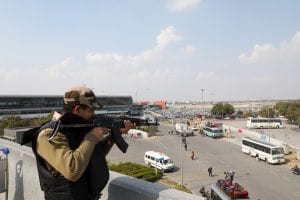Lessons From Kashmir: When Violence Threatens a Fragile Tourism Economy

Skift Take
Last April, I was preparing for a reporting trip to Kashmir—my flights and houseboat on Srinagar’s Dal Lake were booked, and I was plotting out my itinerary. Then, a few days before I was scheduled to travel, violence erupted in the southern region of the state, plunging Srinagar into a bandh, or strike, and my plans into question. “You’ll be fine,” all my Kashmiri friends assured me. “These things happen, tourists are never affected.” In the end, I canceled my trip, more so because restrictions on mobility would affect my reporting, rather than concerns for my safety.
Such uncertainty is, unfortunately, far from uncommon in Kashmir. In 1989, violence erupted in the Kashmir Valley, emanating from Pakistan-sheltered militant groups, resulting in an increased militarization of the Kashmir Valley by Indian armed forces, and unrest has ebbed and flowed ever since. As 2018 went on to become the deadliest year in Kashmir over the past decade, I wondered often about the ethics of traveling to a troubled region where tourists are shielded from the day-to-day struggles faced by citizens. And in light of the latest tensions simmering in that part of the world, bringing India and Pakistan to the brink of war last week, it’s relevant now more than ever.
Kashmir is, no doubt, blessed with all the virtues travelers obsess over: snow-capped peaks, dense pine forests, and terraced Mughal gardens—only without the crowds typically associated with destinations that beautiful. The region might boast the oldest tourism slogan in history, a Persian couplet inscribed on a plaque in Srinagar’s Mughal-era Shalimar Bagh: “If there is a paradise on earth, it is here, it is here, it is here.”
But the scenic Himalayan valley has been in dispute ever since the British departed the subcontinent in 1947, cleaving the region into Hindu-majority India and Muslim-majority Pakistan; two-thirds of the Muslim-majority state of Kashmir, then ruled by a Hindu maharajah, are administered by India, and the rest by Pakistan.
India and Pakistan have fought three wars over Kashmir in the past 70 years, and might be on the brink of a fourth, following an especially eventful last few weeks:: a terrorist attack in Pulwama launched by Pakistan-based terrorist group Jaish-e-Mohammed killed 40 Indian soldiers; India retaliated with air strikes in Pakistan; Pakistan shot down Indian planes and took, then returned, an Indian POW.
Despite the roller coaster ride of the last three decades, tourism remains a significant part of the Kashmiri economy; according to the 2017 J&K Economic Survey, it accounts for just shy of seven percent of the state’s GDP. Much of the local population is involved with tourism, whether directly through the use of hotels, restaurants, and transportation, or indirectly through sales of supplies to businesses or handicrafts to visitors.
The industry mostly caters to domestic travelers, who stay in houseboats in Srinagar, ski in Gulmarg, and make religious pilgrimages to Amarnath and Vaishno Devi; foreigners, on the other hand, are less common. The U.S. State Department advisory bluntly warns: “Terrorist attacks and violent civil unrest are possible in the state of Jammu and Kashmir. Avoid all travel to this state (with the exception of visits to the eastern Ladakh region and its capital, Leh).”

A Pakistani soldier guards Lahore's international airport after it reopened recently. Flights were cancelled after tensions between India and Pakistan escalated to violence. Bloomberg
Whenever turmoil surges, as it is now, livelihoods are impacted. “The first thing that gets affected when something like this happens is tourism—no one wants to travel, and media blows it out of proportion,” says my friend Gulaam Gouse Deewani, founder and director of OMG Luxury Holidays. “When a layman hears it on the news, it puts fear in them. After what has happened in the last two weeks, we had 100 percent cancellations, and we had to refund everyone’s money.”
In light of the attacks, Kashmiris living, studying, and working around the country have been targeted and many have been forced to flee back to Kashmir; some right-wing politicians have called for a boycott of tourism and goods from the state. Most Kashmiris are quick to assure potential visitors that the conflict won’t impact them, and that it’s safe for tourists—and then flights to eight airports in the region were grounded for several hours on Thursday, adding more uncertainty.
But should outsiders visit a place where they have the luxury of traveling in a relatively safe bubble, in stark contrast to the daily reality on the ground? “It’s not a question of not going, it’s a question of being more cognizant of going to Kashmir and knowing what the deal is,” says Ather Zia, an assistant professor at the University of Northern Colorado. “An informed tourist is a benefit for everyone.”
That means visitors should try to dig beneath the surface. “It’s one of the highest militarized zones—how can that be invisible?” Zia asks. “If they still want to come and give a boost to the economy, that’s fine, but if they’re the people who’ve come to see the beautiful nature, they’ll also see militarization. There should be healthy curiosity from every person who visits Kashmir to ask, ‘Why is there so much security, why is this happening?’ If someone treats it as normal and doesn’t have any curiosity to look beyond that, I don’t know what to say to that section of people.”
There’s always a risk associated with traveling to conflict zones, but if you make the decision to do so, it’s important to understand residents’ experiences beyond a superficial level. It’s something I’ll certainly do when I reschedule my canceled trip someday.




